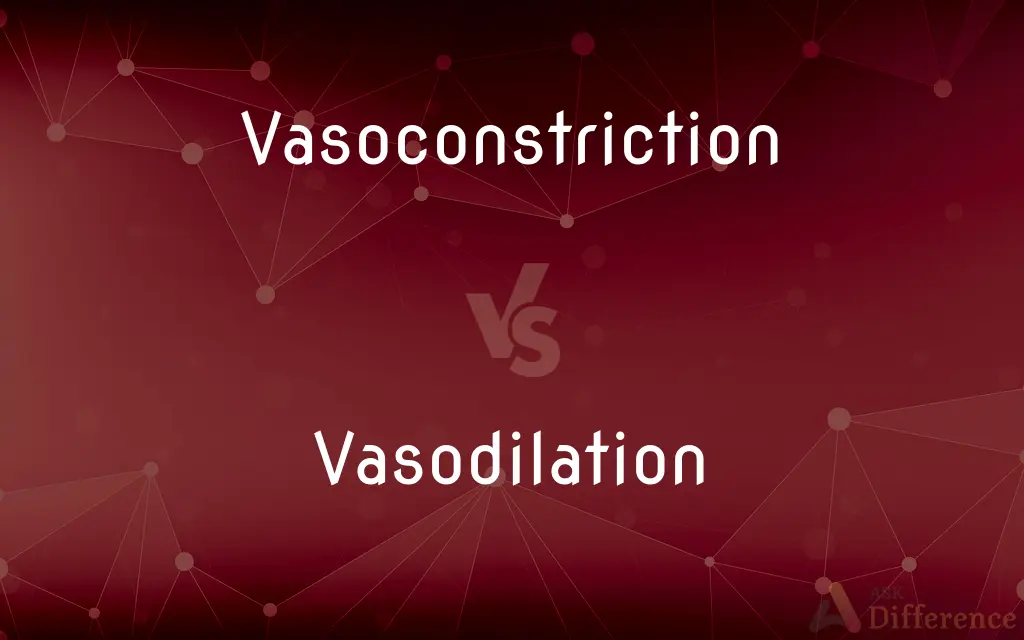Vasoconstriction vs. Vasodilation — What's the Difference?
Edited by Tayyaba Rehman — By Urooj Arif — Updated on April 15, 2024
Vasoconstriction narrows blood vessels increasing blood pressure, while vasodilation widens them, lowering pressure.

Difference Between Vasoconstriction and Vasodilation
Table of Contents
ADVERTISEMENT
Key Differences
Vasoconstriction refers to the narrowing of blood vessels, which results from the contraction of muscular walls of the vessels, primarily the arterioles. On the other hand, vasodilation involves the relaxation of these muscle walls, leading to an increase in the diameter of the blood vessels.
This process of vasoconstriction typically leads to an increase in blood pressure because the narrowed vessel space increases the resistance against the flow of blood. Whereas, vasodilation reduces blood pressure by providing a greater space for blood to flow, thus decreasing resistance.
Vasoconstriction is often a body response to cold temperatures or hormonal changes that require the preservation of heat and an increase in blood flow to vital organs. Conversely, vasodilation occurs in response to warmth, needing to cool the body or during exercise to increase blood flow to the muscles and skin.
Chemically, vasoconstriction can be stimulated by substances such as adrenaline, noradrenaline, and angiotensin, which trigger the contraction of the vascular smooth muscle. Vasodilation, however, is promoted by substances like nitric oxide, carbon dioxide, and histamine that relax the smooth muscle.
In medical treatment, vasoconstrictors are used to treat conditions like hypotension and nasal congestion, by constricting blood vessels and raising blood pressure. Vasodilators, on the other hand, are prescribed for hypertension and angina, as they help lower blood pressure and increase blood flow to the heart.
ADVERTISEMENT
Comparison Chart
Definition
Narrowing of blood vessels due to contraction of muscular walls.
Widening of blood vessels due to relaxation of muscular walls.
Effect on Blood Flow
Decreases blood flow by reducing vessel diameter.
Increases blood flow by enlarging vessel diameter.
Effect on Blood Pressure
Increases blood pressure due to increased vascular resistance.
Decreases blood pressure due to reduced vascular resistance.
Common Stimuli
Cold temperatures, adrenaline, angiotensin.
Warmth, nitric oxide, carbon dioxide.
Medical Use
Used to increase blood pressure and reduce bleeding.
Used to decrease blood pressure and improve blood flow.
Compare with Definitions
Vasoconstriction
Managed clinically with vasoconstrictors.
Vasoconstrictors are often administered to manage severe hypotension.
Vasodilation
Relaxation of blood vessel walls.
Vasodilation can help cool the body during overheating.
Vasoconstriction
Triggered by neurotransmitters like adrenaline.
Adrenaline causes vasoconstriction, preparing the body for 'fight or flight.'
Vasodilation
Managed clinically with vasodilators.
Vasodilators are used to treat conditions like angina.
Vasoconstriction
Response to cold or stress.
Vasoconstriction during stress helps divert blood to vital organs.
Vasodilation
Decrease in blood pressure via widening of vessels.
Vasodilation is critical in managing hypertension.
Vasoconstriction
Contraction of blood vessel walls.
Vasoconstriction in the fingers can lead to feelings of coldness.
Vasodilation
Response to heat or exercise.
Vasodilation increases during exercise to aid muscle performance.
Vasoconstriction
Increase in blood pressure via narrowing vessels.
Vasoconstriction helps raise blood pressure in critical situations.
Vasodilation
Triggered by body chemicals like nitric oxide.
Nitric oxide promotes vasodilation to improve circulation.
Vasoconstriction
Vasoconstriction is the narrowing of the blood vessels resulting from contraction of the muscular wall of the vessels, in particular the large arteries and small arterioles. The process is the opposite of vasodilation, the widening of blood vessels.
Vasodilation
Vasodilation is the widening of blood vessels. It results from relaxation of smooth muscle cells within the vessel walls, in particular in the large veins, large arteries, and smaller arterioles.
Vasoconstriction
Constriction of a blood vessel, as by a nerve or drug.
Vasodilation
Dilation of a blood vessel, as by the action of a nerve or drug.
Vasoconstriction
(physiology) Constriction or narrowing of a blood vessel.
Vasodilation
Dilation or widening of the blood vessels.
Vasoconstriction
Decrease in the diameter of blood vessels
Vasodilation
Dilation of blood vessels (especially the arteries)
Common Curiosities
What causes vasoconstriction?
It can be triggered by cold, stress, or hormones like adrenaline.
What causes vasodilation?
It is commonly caused by warmth, increased carbon dioxide, or chemical signals like nitric oxide.
What is vasodilation?
Vasodilation is the widening of blood vessels that occurs when the smooth muscles in the vessel walls relax.
How do vasoconstriction and vasodilation affect blood pressure?
Vasoconstriction increases blood pressure by narrowing blood vessels, whereas vasodilation decreases it by widening them.
What are examples of vasoconstrictors?
Adrenaline and noradrenaline are examples of natural vasoconstrictors.
Can vasoconstriction and vasodilation occur simultaneously?
Yes, they can occur simultaneously in different parts of the body depending on physiological needs.
What are examples of vasodilators?
Nitric oxide and histamine are examples of substances that cause vasodilation.
How is vasodilation used in medical treatment?
Vasodilators are used to treat high blood pressure and cardiac conditions.
How is vasoconstriction used in medical treatment?
It is used to increase blood pressure in patients with hypotension.
What effects does vasodilation have on the skin?
It often causes the skin to appear redder and feel warmer.
What role does vasoconstriction play in the body?
It helps in regulating blood flow and pressure, and conserving heat.
What role does vasodilation play in the body?
It aids in cooling the body, improving blood flow, and lowering blood pressure.
What effects does vasoconstriction have on the skin?
It can cause the skin to appear paler due to reduced blood flow.
How do temperature changes affect vasoconstriction and vasodilation?
Cold temperatures typically trigger vasoconstriction, while warmer temperatures induce vasodilation.
Share Your Discovery

Previous Comparison
Proof vs. Evidence
Next Comparison
Lethal vs. MortiferousAuthor Spotlight
Written by
Urooj ArifUrooj is a skilled content writer at Ask Difference, known for her exceptional ability to simplify complex topics into engaging and informative content. With a passion for research and a flair for clear, concise writing, she consistently delivers articles that resonate with our diverse audience.
Edited by
Tayyaba RehmanTayyaba Rehman is a distinguished writer, currently serving as a primary contributor to askdifference.com. As a researcher in semantics and etymology, Tayyaba's passion for the complexity of languages and their distinctions has found a perfect home on the platform. Tayyaba delves into the intricacies of language, distinguishing between commonly confused words and phrases, thereby providing clarity for readers worldwide.














































